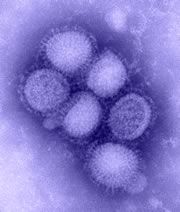
H1N1 (referred to as “swine flu” early on) is a new influenza virus causing illness in people. This new virus was first detected in people in the United States in April 2009. Other countries, including Mexico and Canada, have reported people sick with this new virus. This virus is spreading from person-to-person, probably in much the same way that regular seasonal influenza viruses spread.
Why is this new H1N1 virus sometimes called “swine flu”?
This virus was originally referred to as “swine flu” because laboratory testing showed that many of the genes in this new virus were very similar to influenza viruses that normally occur in pigs in North America. But further study has shown that this new virus is very different from what normally circulates in North American pigs. It has two genes from flu viruses that normally circulate in pigs in Europe and Asia and avian genes and human genes. Scientists call this a “quadruple reassortant” virus.
H1N1 flu updates....
The ongoing outbreak of novel influenza A (H1N1) continues to expand in the United States. CDC expects that more cases, more hospitalizations and more deaths from this outbreak will occur over the coming days and weeks.
U.S. Human Cases of H1N1 Flu Infection
(As of May 7, 2009, 11:00 AM ET)
TOTAL
States (41)
Laboratory confirmed cases - 896
Deaths - 2
International Human Cases of Swine Flu Infection,
see World Health Organization
Antiviral Guidance
CDC has issued guidance for health care providers on the use of antiviral medications during the current outbreak. The priority use for influenza antiviral drugs is to treat severe influenza illness and people who are at high risk of serious influenza-related conditions.
School Guidance
At this time, CDC recommends the primary means to reduce spread of influenza in schools focus on early identification of ill students and staff, staying home when sick, and good cough etiquette and frequent hand washing. Decisions about school closure should be at the discretion of local authorities based on local considerations. (See the School Guidance.)
Increased Testing
CDC has developed a PCR diagnostic test kit to detect this novel H1N1 virus and has now distributed test kits to all states in the U.S. and Puerto Rico. The test kits are being shipped internationally as well. This will allow states and other countries to test for this new virus. This increase in testing capacity is likely to result in an increase in the number of reported confirmed cases in this country, which should provide a more accurate picture of the burden of disease in the United States.
To read more about the Swine flu virus please click the link below:
cdc.gov